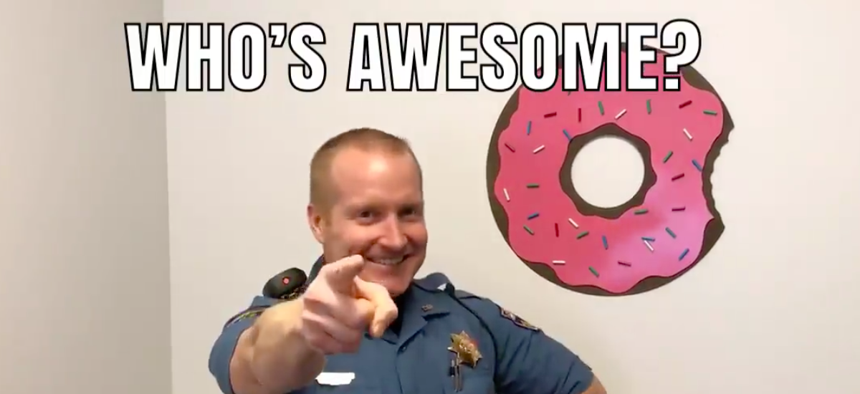How a State Police Agency Goes Viral (and Maybe Teaches People How to Drive)

Donuts are a frequent guest star in Trooper Josh Lewis' videos. Colorado State Patrol
The Colorado State Patrol develops relationships with the community and grows its online presence by posting humorous topical videos, a project spearheaded by one of its public information officers.
On a given day at work, Colorado State Trooper Josh Lewis might throw down with a colleague over a box of donuts, freak out state residents by repeatedly describing weather conditions as "moist" or teach drivers how to use their turn signals (using them at all would be a good start).
As one of the Colorado State Patrol’s public information officers, Lewis’ main responsibility is disseminating information to journalists and members of the public. Since 2012, he’s been doing so partly by filming videos and posting them to the agency’s social media channels. Some are straightforward updates, but most—and by far the most popular—are humorous, often snarky takes on driving etiquette and traffic laws, ranging from tailgating (in which Lewis skulks around behind his coworkers) to parking (where he sits in a parking space and insists the lines are your friends). Also, exploring the allure of donuts. There’s a lot of content about donuts.
“We embrace that cops-love-donuts stereotype wholeheartedly,” Lewis said. “Because we know other people will kind of embrace that as well.”
Lewis’ videos go viral semi-frequently; most recently, a tongue-in-cheek post about the proper use of the left lane (it’s for passing, not cruising, thanks) got picked up by Buzzfeed and racked up more than 16 million views.
In general, the clips are lighthearted, but their purpose is serious—to convey information, yes, but also to grow the state agency’s online audience. That means officials can more quickly disseminate important information when needed, such as during natural disasters and other emergencies.
“We want the fun messaging to get out, but widely, when we have these big emergency situations, we want to be able to reach the biggest audience as quickly as possible,” Lewis said. “In order to do that, we have to continue to grow our audience so they are paying attention when something happens—or at the very least, so they know they can come to our accounts to try to find information.”

The videos have helped the agency move toward that goal, capturing attention across the country and, in some cases, across the world. The growth began after Lewis asked to take over the state patrol's barely used social media channels.
“Nobody was all that interested in seeing what they could do, so I asked if I could give it a try. I started using it more and more, from a couple times a month to a couple times a week to daily to a few times a day,” he said. “It’s become a fantastic resource for us to use to get our messaging out.”
It's proven effective. In January 2012, the state patrol’s Facebook page had roughly 1,200 followers, which had grown to 46,000 five years later. One of Lewis’ videos went viral for the first time in January 2017, bringing with it 10,000 new followers. Weekly videos started that year; the 100,000th follower came in July 2018. As of today, more than 137,000 people follow the page.
Inspiration for videos comes from all sorts of different sources, including Lewis himself, people who work in the office building, emails from the public and comment sections of previous videos. If the clip features Lewis in his patrol car, it’s typically shot on his phone. For more elaborate setups, Lewis enlists help from fellow trooper Gary Cutler and Sgt. Blake White, his direct supervisor—but Lewis himself is always the face of the operation, a setup he says the others are fine with.
“We’ve discussed it, and I’ve tried to get (Cutler) incorporated more into it, but he’s much more comfortable behind the camera, doing the editing,” he said. “It’s why our team works so well. I have no problem going up there and looking foolish, and he’s perfectly happy to do the editing.”
Topics are broad, but usually related to road etiquette or law enforcement and, as a rule, stray far from controversial issues. Tone matters, Lewis said, and so does timing. Sometimes, Lewis must address extremely somber topics.
“For what it’s worth, we’ve lost five members of our agency in the past four years. I’ve been on four of those crash scenes and I knew the fifth one very well,” Lewis said. “So certainly when it becomes time to be very serious and get that important messaging across, that’s what we do.”
But for either type of message, the goals remain the same: convey important information, do so appropriately, and help build relationships between law enforcement officials and the communities they serve.
“It falls under the idea of the 21st-century policing model of being engaged in our communities. We want people to be able to approach us,” Lewis said. “We feel this manages to get us out there—not just our agency, but the law enforcement profession in general. We’re part of the community, we’re real human beings. We have emotions. We're allowed to laugh and have fun with it."
For Lewis, at least, the project has made a difference in approachability. He gets recognized occasionally and is never quite sure how to handle it, save for once when a woman flagged him down in the middle of a traffic jam on the interstate. Responding to that one, he said, was easy.
“It was bumper-to-bumper traffic and she rolled down the window and wanted to talk,” he said. “She said she really appreciated the videos. And I had to remind her that in a traffic jam on a busy highway was really not the time and place to discuss it.”
Kate Elizabeth Queram is a Staff Correspondent for Route Fifty and is based in Washington, D.C.
NEXT STORY: Why State and Local Governments Are Suing Over Climate Change





